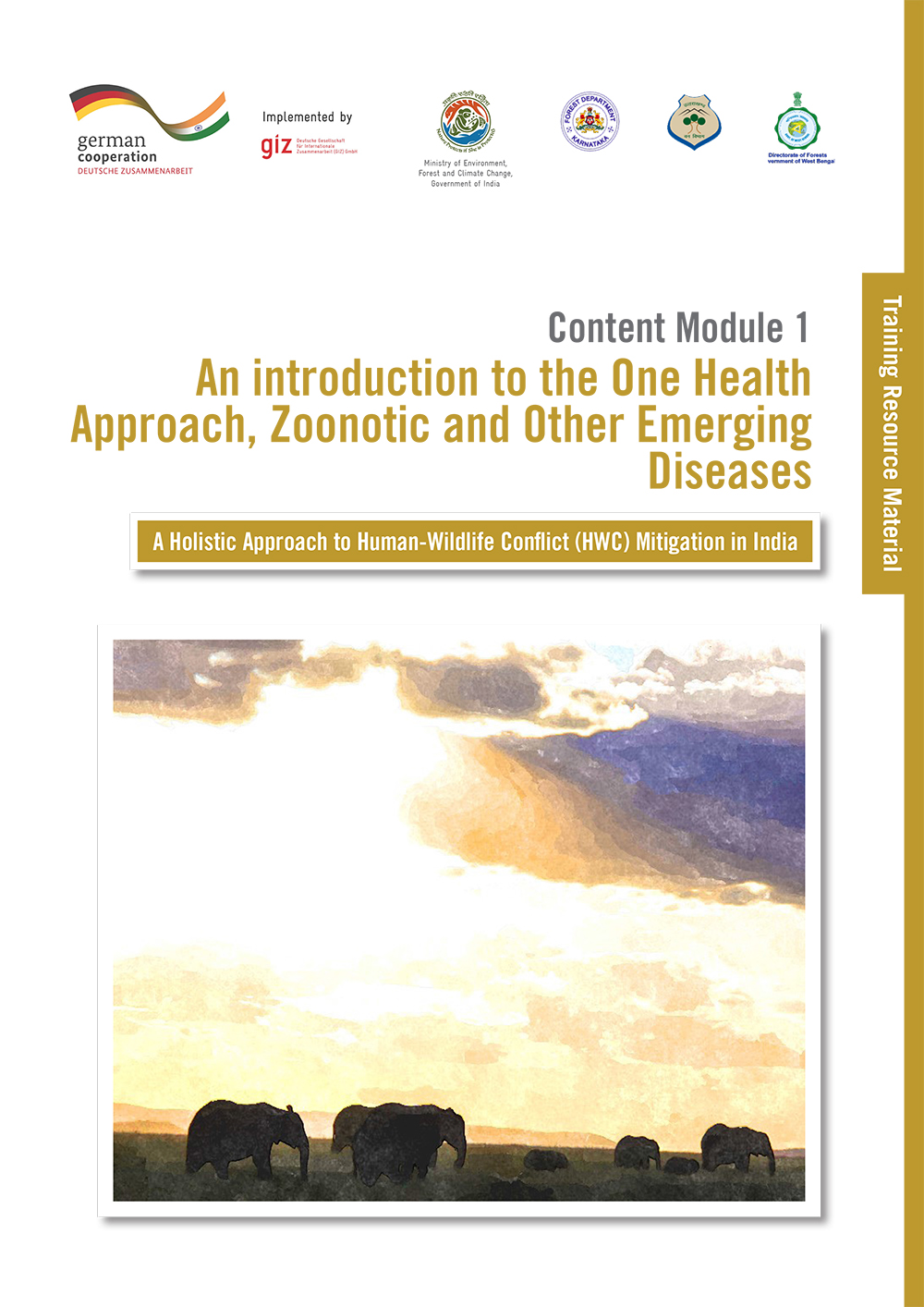Local communities are at the direct helm of HWC. Therefore, there is a need to involve local community members/village elders of panchayats through a participatory approach and develop a community-based emergency response system from within an affected village/ward. The formation and empowerment of community-level Primary Response Teams (Community PRT) in villages/wards or village/ward clusters at HWC hotspots is expected to improve the first response mechanism, support the efforts of the division and range RRTs and especially play a crucial role in crowd management in HWC situations. Training programmes and workshops conducted for panchayats and members of community-level Primary Response Teams focus on reducing accidental encounters, enhancing the competencies of Community PRT members and reducing their vulnerability to human-wildlife conflict and zoonotic diseases by raising awareness.
The training programmes and courses based on this curriculum are intended to create a cadre of community members supporting in the planning, development and implementation of effective and wildlife-friendly HWC mitigation measures.
The curriculum is designed for Community PRTs. Moreover, the curriculum is also suitable for training programmes on HWC mitigation and One Health for panchayat members, members of other community-based institutions, women groups and youth.
The following training sessions have been designed in line with the Supplementary Framework to HWC-NAP on Establishment and Capacity Development of HWC Mitigation Response Teams:
After each session, a reflection exercise should be conducted to discuss the required changes in the curriculum/ training methods/ any other element.
Possible learning outcomes of the Trainings based on this curriculum
Basics of wildlife behaviour and measures to avoid accidental encounters with wildlife
At the end of the programme, the participants are able to:
Mitigating human-wildlife conflict effectively: Maintenance of the mitigation measures and structures (basic)
At the end of the programme, the participants are able to:
Preventing zoonotic and other emerging diseases: Taking a One Health approach to HWC mitigation
At the end of the programme, the participants are able to:
Adopting HWC-safe livelihoods for reducing the vulnerability to humanwildlife conflicts
At the end of the programme, the participants are able to:
Emergency response plan for HWC-related emergencies in the district: Role of Community PRTs
At the end of the programme, the participants are able to:

Content Module HWC-01: An Introduction to Human-Wildlife Conflict Mitigation: Taking a Holistic and Harmonious Coexistence Approach
This module facilitates comprehension of the basic concepts of biodiversity, wildlife and ecosystem services leading to a profound understanding of the fundamentals of human-wildlife conflict (HWC), its drivers and pressures, current state and trends, impacts and current response measures. At the same time, participants will be encouraged to think and discuss a holistic approach to HWC mitigation, i.e., the drivers, prevention and reduction of impacts, traditional and indigenous measures, and the relevant sectors and key stakeholders in India. The first section facilitates the participants in getting a deeper and more comprehensive understanding of the harmonious coexistence approach, holistic approach to mitigating human–wildlife conflict and One Health. Section two of the module provides an HWC profile of selected wildlife species-in-conflict, intended to prevent accidental encounters and to design effective and wildlife-friendly mitigation measures that are aligned with animal behaviour and ecology.

Content Module HWC-02: The Overall Context: Understanding HWC in a Development Context
This module facilitates the participants in developing an understanding of human-wildlife conflict and its mitigation in the overall development context. The concepts and issues related to the holistic approach to HWC mitigation are presented using the DPSIR approach, i.e., drivers, pressures, state, impact and response. With this module, the participants explore the relevance of corridors and landscape connectivity as one of the HWC mitigation measures while appraising the impact of land-use change on HWC. The module facilitates discussions on the relevance and significance of cross-sector cooperation in addressing the issue of HWC. The training sessions will sensitise and equip the participants in designing holistic HWC mitigation measures, which also address the needs and requirements of the most vulnerable and socially disadvantaged groups.

Content Module HWC-03: Legal, Policy, and Administrative Framework for HWC Mitigation in India
This module facilitates a discussion on the conservation ethos of India in relation to its legal framework. It presents an outline and brief history of international conventions and treaties relevant to the conservation of wildlife and, in particular, to HWC mitigation. The primary aim of this module is to serve as a compendium of key regulations, policies, customary rules, guidelines and SOPs related to HWC mitigation in India. The module also provides an analysis of some relevant HWC cases and specific learning points from these cases. The module thus provides information and guiding questions to facilitate a discussion on the application of current legal provisions to the mitigation of HWC in India.

Content Module OH-01: An Introduction to the One Health Approach, Zoonotic and Other Emerging Diseases
This module brings conceptual, analytical and contextual clarity among participants on the One Health concept and approach in the overall development context. It highlights the relevance of the One Health approach in managing the protected areas and wildlife and mitigating the human-wildlife conflict. Additionally, the module provides a thorough explanation of some critical zoonotic and other emerging diseases, including their key drivers such as ecological changes, habitat loss, wildlife trade, the increased interface between human-animal, bushmeat hunting and consumption, animal husbandry practices, impacts and prevention measures. Participants will be introduced to basic concepts of cross-sector cooperation, international and national frameworks, policy and programmes on One Health.
© 2014 IGBP. All Rights Reserved.
Site By: Virtualpages
